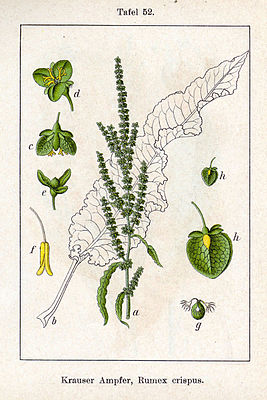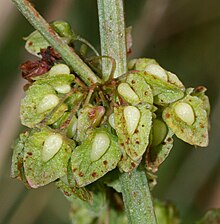Curled dock
| Curled dock | ||||||||||||
|---|---|---|---|---|---|---|---|---|---|---|---|---|

Krauser Ampfer ( Rumex crispus ), illustration |
||||||||||||
| Systematics | ||||||||||||
|
||||||||||||
| Scientific name | ||||||||||||
| Rumex crispus | ||||||||||||
| L. |
The curly dock ( Rumex crispus ) is a species of the knotweed family (Polygonaceae). Its name comes from the leaves of the leaves that curl around the edge.
description
The Krause dock is an evergreen, perennial, herbaceous plant that reaches heights of about 30 to 150 centimeters. The basal leaves are provided with a truncated heart-shaped base and end pointed. The blade of the basal leaves is four to eight times as long as it is wide, up to 40 cm long and strongly curled at the edge.
The valves are always whole and wider than the callus that is present on at least one valve. This is large, develops early and hardens. The fruit stalks are usually twice as long as the Valven and shaped like a broad top. The fruits are on average only 1.5 to 1.8 mm wide.
The Krause dock flowers in Central Europe from June to August.
The number of chromosomes is 2n = 60.
Occurrence
The originally Eurasian curly dock is widespread as a neophyte in areas with a moderate climate worldwide. It is widespread throughout Germany .
It occurs in weed corridors, on banks, ditches, in fields, in goose fish and in wet meadows. He prefers solidified, heavy, nutrient-rich loam and clay soil. According to Ellenberg , it is a half-light plant, a moderate heat pointer, a moisture pointer, growing on moderately nitrogen-rich sites and a class character of the creeping ostrich lawn or flood lawn (Agrostietea stoloniferae). According to Oberdorfer , it is a character species of the Agropyro-Rumicion association, but also occurs in societies of the Molinio-Arrhenatheretea class. In the Allgäu Alps in Vorarlberg, near the Auenhütte am Ifen , it rises to an altitude of 1270 meters.
ecology
The Krause dock is a pioneer plant that has roots up to 3 m deep. It is one of the hemicryptophytes .
It is andromonözisch with male hermaphroditic flowers. The flowers are pollinated by the wind. Due to the separate position of the two sexes, self-pollination within the flower is impossible. Because of the smooth diaspores, there is certainly no Velcro spreading, but water spreading is likely. Most of the time, wind spreads. The seeds can remain viable for many years.
Taxonomy
The scientific name Rumex crispus was first published in 1753 by Carl von Linné in Species Plantarum .
Toxicity
The plant is slightly poisonous, especially when dried, due to its oxalate content. The main active ingredients are potassium oxalate , free oxalic acid , tannins and anthraquinones . Mechanism of action: local irritation; absorbed oxalic acid binds blood calcium and leads to hypocalcaemia. The calcium oxalate crystals damage the kidneys when excreted. Symptoms of poisoning are: vomiting, diarrhea, colic, cardiac arrhythmias, hypotension, tremors, paralysis, hematuria / anuria, etc.
Poisoning with fatal outcome in children and animals is known; If there are mass occurrences in meadows, grazing cattle can also be poisoned; Horses and sheep are sensitive, cattle a little more tolerant because the amount of oxalate-degrading microorganisms in the rumen increases.
Use in medicine
In folk medicine, the root of the krausen ampfers (drug name: Rumex crispus, Radix or Rumicis crispi Radix) is only used occasionally, especially for skin diseases and intestinal affections. The use in constipation is at least plausible due to the laxative anthraquinones contained in the drug . Tests have shown that the drug has antioxidant and antibacterial properties. Nepodin, an ingredient of the frizzy amper, also shows activity against the malaria pathogen.
Rumex crispus is still used in potentised form in homeopathy .
swell
literature
- Erich Oberdorfer : Plant-sociological excursion flora for Germany and neighboring areas . With the collaboration of Angelika Schwabe and Theo Müller. 8th, heavily revised and expanded edition. Eugen Ulmer, Stuttgart (Hohenheim) 2001, ISBN 3-8001-3131-5 .
- Siegmund Seybold (Ed.): Schmeil-Fitschen. Interactive flora of Germany. Seeing - determining - knowing. The key to the flora . CD-ROM, version 2.0. Quelle & Meyer, Wiebelsheim 2004, ISBN 3-494-01368-3 .
- Sergei L. Mosyakin: Rumex. In: Flora of North America Editorial Committee (Ed.): Flora of North America North of Mexico . Volume 5: Magnoliophyta: Caryophyllidae, part 2 . Oxford University Press, New York / Oxford a. a. 2005, ISBN 0-19-522211-3 , pp. 522-523 (English, online ). (engl.)
- Margot Spohn, Marianne Golte-Bechtle: What is blooming there? The encyclopedia: over 1000 flowering plants from Central Europe. Kosmos, Stuttgart 2005, ISBN 3-440-10326-9 .
Individual evidence
- ↑ a b Erich Oberdorfer : Plant-sociological excursion flora for Germany and neighboring areas . With the collaboration of Angelika Schwabe and Theo Müller. 8th, heavily revised and expanded edition. Eugen Ulmer, Stuttgart (Hohenheim) 2001, ISBN 3-8001-3131-5 , pp. 330 .
- ↑ Heinz Ellenberg : Vegetation of Central Europe with the Alps in an ecological, dynamic and historical perspective (= UTB for science. Large series . Volume 8104 ). 5th, heavily changed and improved edition. Eugen Ulmer, Stuttgart (Hohenheim) 1996, ISBN 3-8252-8104-3 , pp. 1057 .
- ↑ Erhard Dörr, Wolfgang Lippert : Flora of the Allgäu and its surroundings. Volume 1, IHW, Eching 2001, ISBN 3-930167-50-6 , p. 442.
- ↑ a b Ruprecht Düll , Herfried Kutzelnigg : Pocket dictionary of plants in Germany. A botanical-ecological excursion companion to the most important species . 6th, completely revised edition. Quelle & Meyer, Wiebelsheim 2005, ISBN 3-494-01397-7 , p. 412 .
- ↑ Carl von Linné: Species Plantarum. Volume 1, Lars Salvius, Stockholm 1753, p. 335 ( digitized version ).
- ^ Gerhard Madaus : Textbook of biological remedies. Volume 3. Olms, Hildesheim 1938.
- ↑ S. Baskan, A. Daut-Ozdemir et al. a .: Analysis of anthraquinones in Rumex crispus by micellar electrokinetic chromatography. In: Talanta . Volume 71, No. 2, 2007, pp. 747-750, doi : 10.1016 / j.talanta.2006.05.018 , PMID 19071368 .
- ↑ Ali Yıldırım, Ahmet Mavi, Ayşe Aydan Kara: Determination of antioxidant and antimicrobial activities of Rumex crispus L. extracts. In: Journal of Agricultural and Food Chemistry . Volume 49, No. 8, 2001, pp. 4083-4089, PMID 11513714 , DOI: 10.1021 / jf0103572 .
- ^ KH Lee, KH Rhee: Antimalarial activity of nepodin isolated from Rumex crispus. In: Archives of Pharmacal Research . Volume 36, No. 4, 2013, pp. 430-435, doi : 10.1007 / s12272-013-0055-0 , PMID 23440579 .
Web links
- Curled dock. In: FloraWeb.de.
- Distribution map for Germany. In: Floraweb .
- Rumex crispus L. In: Info Flora , the national data and information center for Swiss flora .
- Distribution in the northern hemisphere from: Eric Hultén, Magnus Fries: Atlas of North European vascular plants. 1986, ISBN 3-87429-263-0 at Den virtuella floran. (swed.)
- Thomas Meyer: Data sheet with identification key and photos at Flora-de: Flora von Deutschland (old name of the website: Flowers in Swabia )
Harmful effect:
- Krauser Ampfer on oekolandbau.de
Photos:
- Günther Blaich: Photos of European plants.
- naturgucker.de on Flickr


